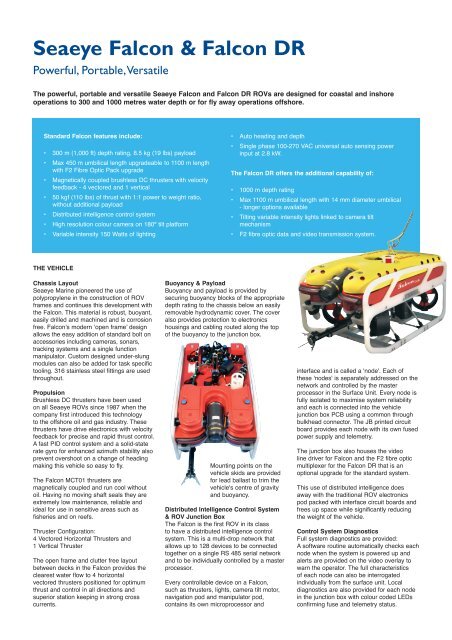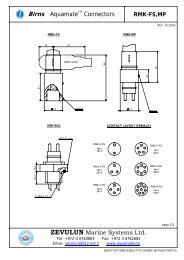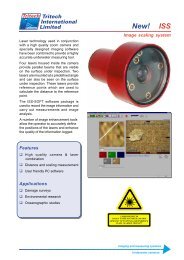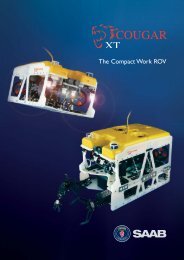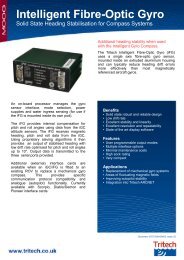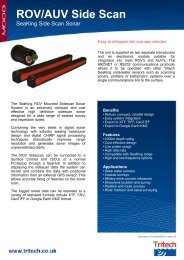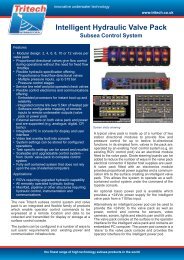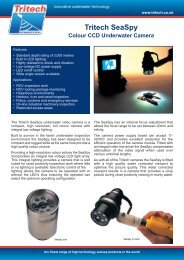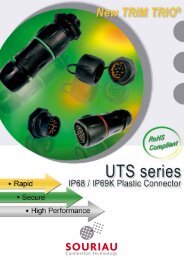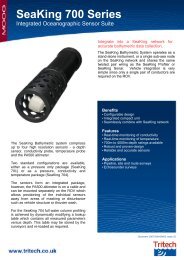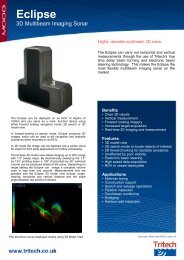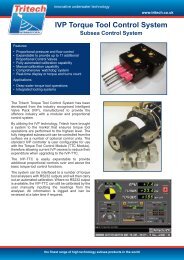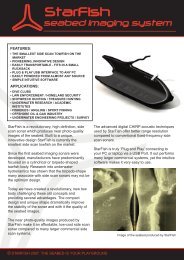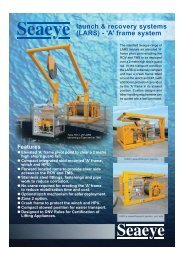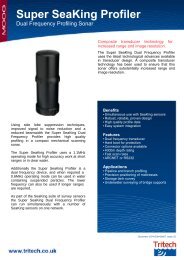Seaeye Falcon & Falcon DR - Marine Solutions
Seaeye Falcon & Falcon DR - Marine Solutions
Seaeye Falcon & Falcon DR - Marine Solutions
Create successful ePaper yourself
Turn your PDF publications into a flip-book with our unique Google optimized e-Paper software.
<strong>Seaeye</strong> <strong>Falcon</strong> & <strong>Falcon</strong> <strong>DR</strong><br />
Powerful, Portable,Versatile<br />
The powerful, portable and versatile <strong>Seaeye</strong> <strong>Falcon</strong> and <strong>Falcon</strong> <strong>DR</strong> ROVs are designed for coastal and inshore<br />
operations to 300 and 1000 metres water depth or for fly away operations offshore.<br />
Standard <strong>Falcon</strong> features include:<br />
• 300 m (1,000 ft) depth rating, 8.5 kg (19 lbs) payload<br />
• Max 450 m umbilical length upgradeable to 1100 m length<br />
with F2 Fibre Optic Pack upgrade<br />
• Magnetically coupled brushless DC thrusters with velocity<br />
feedback - 4 vectored and 1 vertical<br />
• 50 kgf (110 lbs) of thrust with 1:1 power to weight ratio,<br />
without additional payload<br />
• Distributed intelligence control system<br />
• High resolution colour camera on 180º tilt platform<br />
• Variable intensity 150 Watts of lighting<br />
• Auto heading and depth<br />
• Single phase 100-270 VAC universal auto sensing power<br />
input at 2.8 kW.<br />
The <strong>Falcon</strong> <strong>DR</strong> offers the additional capability of:<br />
• 1000 m depth rating<br />
• Max 1100 m umbilical length with 14 mm diameter umbilical<br />
- longer options available<br />
• Tilting variable intensity lights linked to camera tilt<br />
mechanism<br />
• F2 fibre optic data and video transmission system.<br />
THE VEHICLE<br />
Chassis Layout<br />
<strong>Seaeye</strong> <strong>Marine</strong> pioneered the use of<br />
polypropylene in the construction of ROV<br />
frames and continues this development with<br />
the <strong>Falcon</strong>. This material is robust, buoyant,<br />
easily drilled and machined and is corrosion<br />
free. <strong>Falcon</strong>’s modern ‘open frame’ design<br />
allows the easy addition of standard bolt on<br />
accessories including cameras, sonars,<br />
tracking systems and a single function<br />
manipulator. Custom designed under-slung<br />
modules can also be added for task specific<br />
tooling. 316 stainless steel fittings are used<br />
throughout.<br />
Propulsion<br />
Brushless DC thrusters have been used<br />
on all <strong>Seaeye</strong> ROVs since 1987 when the<br />
company first introduced this technology<br />
to the offshore oil and gas industry. These<br />
thrusters have drive electronics with velocity<br />
feedback for precise and rapid thrust control.<br />
A fast PID control system and a solid-state<br />
rate gyro for enhanced azimuth stability also<br />
prevent overshoot on a change of heading<br />
making this vehicle so easy to fly.<br />
The <strong>Falcon</strong> MCT01 thrusters are<br />
magnetically coupled and run cool without<br />
oil. Having no moving shaft seals they are<br />
extremely low maintenance, reliable and<br />
ideal for use in sensitive areas such as<br />
fisheries and on reefs.<br />
Thruster Configuration:<br />
4 Vectored Horizontal Thrusters and<br />
1 Vertical Thruster<br />
The open frame and clutter free layout<br />
between decks in the <strong>Falcon</strong> provides the<br />
clearest water flow to 4 horizontal<br />
vectored thrusters positioned for optimum<br />
thrust and control in all directions and<br />
superior station keeping in strong cross<br />
currents.<br />
Buoyancy & Payload<br />
Buoyancy and payload is provided by<br />
securing buoyancy blocks of the appropriate<br />
depth rating to the chassis below an easily<br />
removable hydrodynamic cover. The cover<br />
also provides protection to electronics<br />
housings and cabling routed along the top<br />
of the buoyancy to the junction box.<br />
Mounting points on the<br />
vehicle skids are provided<br />
for lead ballast to trim the<br />
vehicle's centre of gravity<br />
and buoyancy.<br />
Distributed Intelligence Control System<br />
& ROV Junction Box<br />
The <strong>Falcon</strong> is the first ROV in its class<br />
to have a distributed intelligence control<br />
system. This is a multi-drop network that<br />
allows up to 128 devices to be connected<br />
together on a single RS 485 serial network<br />
and to be individually controlled by a master<br />
processor.<br />
Every controllable device on a <strong>Falcon</strong>,<br />
such as thrusters, lights, camera tilt motor,<br />
navigation pod and manipulator pod,<br />
contains its own microprocessor and<br />
interface and is called a 'node'. Each of<br />
these 'nodes' is separately addressed on the<br />
network and controlled by the master<br />
processor in the Surface Unit. Every node is<br />
fully isolated to maximise system reliability<br />
and each is connected into the vehicle<br />
junction box PCB using a common through<br />
bulkhead connector. The JB printed circuit<br />
board provides each node with its own fused<br />
power supply and telemetry.<br />
The junction box also houses the video<br />
line driver for <strong>Falcon</strong> and the F2 fibre optic<br />
multiplexer for the <strong>Falcon</strong> <strong>DR</strong> that is an<br />
optional upgrade for the standard system.<br />
This use of distributed intelligence does<br />
away with the traditional ROV electronics<br />
pod packed with interface circuit boards and<br />
frees up space while significantly reducing<br />
the weight of the vehicle.<br />
Control System Diagnostics<br />
Full system diagnostics are provided:<br />
A software routine automatically checks each<br />
node when the system is powered up and<br />
alerts are provided on the video overlay to<br />
warn the operator. The full characteristics<br />
of each node can also be interrogated<br />
individually from the surface unit. Local<br />
diagnostics are also provided for each node<br />
in the junction box with colour coded LEDs<br />
confirming fuse and telemetry status.


